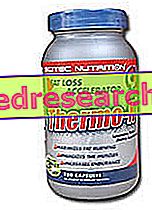Watch the video
X Watch the video on youtubeUnder the term "domestic or domestic feeding of the dog" is included a heterogeneous set of nutritional modalities ranging from the exclusive use of leftovers from the table, to the use of finely processed rations to satisfy the nutritional needs of the dog.

The various ingredients can naturally replace each other, since their nutritional value is roughly equivalent. However, in order not to make mistakes, it is important to know well the foods allowed and those to be avoided, or to be given sparingly.
Croquettes or Homemade Food?
Note, however, that the dog is not a machine, but something far more complicated and close to perfection; consequently - within reasonable limits - it is perfectly capable of adapting its metabolism to the type of feeding received. In other words, dosing individual nutrients to perfection is not as important as the detractors of the home diet, as well as avid supporters of dog feed, would have us believe.
Given the objective difficulty in interpreting the label of pet food, and above all to trace the clear origin of the raw materials, there are still many people who prefer to opt for a household-type diet.
The widespread fear is that industrial products may contain substances that are harmful to the dog, such as additives (colorings, flavorings, etc.), poor quality raw materials or substances added for fraudulent purposes (see melamine scandal).
Many owners of dogs and cats, therefore, eschew the idea of basing their animal's diet entirely on these "artificial" products, therefore lacking any connotation that can make them authentic, natural and "alive". We must not forget the widespread and certainly not groundless fear that the waste from slaughtering and cereals, not suitable for human consumption (entrails, bones, cartilages, rancid fats, diseased parts, cereal grains contaminated by mycotoxins, etc.), come into somehow recycled in pet food production.
Ultimately, industrial food for dogs raises many doubts for the average consumer, even for the one who systematically uses it for time, practicality and economy.
Croquettes Recipe for Homemade Dogs »
Importance of the Transition
Before analyzing what to put and what not to put in the bowl, it is good to remember that in the administration of a food the so-called transition rule must always be respected.
In practice, sudden food changes should be avoided, which could cause the onset of gastrointestinal phenomena. Rather, the individual foods should be replaced gradually over a week, changing the old food with the new one through the administration of scalar and increasing doses of both.
Humans love to diversify their diet, but this does not apply to the dog and especially to its digestive system; therefore, by continually varying the feeding of the dog - without operating the necessary transition phase - there is the risk of causing digestive imbalance to the animal.
Furthermore, we must remember that the dog has very few taste buds, but an extremely developed sense of smell; consequently, the aroma of food plays an important role in the choice of foods, so that puppies that are weaned with home-made foods will then have difficulty accepting industrial feed, and vice versa.
Recommended and Prohibited Foods
The so-called housewife diet consists essentially of the combination of meat + starchy sources + vegetables, with the addition of possible additions (vegetable oils, vitamin supplements, bone meal, dietary yeast, etc.).
The preparation of a meal based on meat (beef, turkey or chicken), well-cooked rice or pasta, vegetables (boiled carrots and zucchini), is certainly very demanding for the owner, but more appreciated by the dog than industrial foods.
Meat
As anticipated, the dog is an omnivorous animal with a predilection for meat, which must be administered in doses more or less equivalent to the amylaceous source (rice or pasta), also considering its lipid content (fatty meats will obviously be administered in doses lower).
Among the meat, raw pork should be avoided due to the risk of pseudorabies, lethal encephalitis caused by a virus to which man is immune.
Cold cuts should be administered with maximum moderation, due to the high presence of sodium and potentially dangerous preservatives (nitrites and nitrates).
fish
Fish is an important source of animal proteins and essential fats from the omega-3 series, in particular EPA and DHA deficient in vegetable oils. It should be served cooked and without bones, very dangerous for the dog; alternatively you can use a complementary feed based on fishmeal.
wet or dry?
The dog likes more a wet food than a dry one, a hot ration compared to a cold one, and a plate rich in fat compared to a poor one of these nutrients.
milk, cereals, fats and eggs
As an adult, the dog hardly tolerates lactose, so the administration of large doses of milk could induce the appearance of diarrhea.
Even starches and carbohydrates are generally digested with some difficulty, so it is advisable to administer overcooked pasta and rice, without overdoing the quantities.
On the other hand, the dog tolerates fats very well, which represent the main energy source of the animal, especially if sedentary.
The administration of cold food from the fridge or too hot, raw egg (due to the presence of avidin in the albumen, an anti-nutrient that can lead to vitamin deficiencies) or excessive or too frequent ration of liver (food of which the dog is particularly fond of, but that at high doses can cause intoxication from vitamin A overload).
The yolk or egg yolk, on the other hand, is also excellent raw, because it is rich in fats and vitamins, but without avidin.
bones
As everyone or almost knows, a delicacy to avoid is represented by the bones of chicken and rabbit, as well as pork chops ; either because of its small size or because of its reduced consistency, these bones can easily break into sharp and sharp segments, potentially capable of suffocating the animal, obstructing the intestine or damaging the gastrointestinal tract walls.
Moreover, we must not forget that dogs have a great need to chew and that often feeding does not allow them to adequately satisfy this need. Therefore, from time to time, you can let them have fun with an ox bone that can be gnawed.
sweets and chocolate
To ban in the bowl of your dog are also sweets, chocolate, seasoned cheeses and fatty sausages, all foods to be administered at most as a small sop at the end of a meal (note that 200 grams of extra-dark chocolate can kill a 12 kg dog) and to be avoided in elderly or overweight dogs.
leftovers
The leftovers of our food should not constitute more than a quarter, a maximum of one third of the animal's diet, avoiding in any case the foods advised against during the article.
don't give in to flattery
Very important thing is that the bosses do not allow themselves to be easily dissuaded by the request for extra food, since the dogs would soon develop refined persuasive techniques which it would be really hard to resist. However, giving in to such things would increase the risk of the animal becoming obese and suffering from diseases related to severe overweight.
no to grapes and raisins
Although the reason is not clear, the ingestion of grapes and raisins by the dog may cause kidney failure. Repeated episodes of vomiting and signs of hyperactivity are the first symptoms of this intoxication; after which, within a day, the dog becomes lethargic and depressed. The best prevention in this regard is to put grapes and raisins on shelves that are not accessible to the dog.
no to alcohol
Beer , liqueurs, wine and spirits in general should not be given to the dog in any way.
This is because in animals the alcohol has the same effect on the liver and brain as on humans. Moreover, much less is needed to cause problems for the dog, such as vomiting, diarrhea, depression of the central nervous system, problems with coordination, difficulty in breathing and coma until death. Remember, in this regard, that the smaller the dog is, the greater the harmful effect of alcohol (with the same dose administered).
no to garlic and onions
The feeding of the dog should be free of garlic and onions, which already in small doses produce a negative effect on the health of the circulating red blood cells. Therefore, the ingestion of these foods, directly or indirectly, risks causing a real haemolytic anemia, which in some cases can be fatal.
The signs of toxicity appear 1-4 days after ingestion of the onions; vomiting, diarrhea and dark-colored urine are the main clinical signs. It should be noted that very often onion powder is present as a flavoring in human homogenates, which must therefore be excluded from feeding the dog, especially if it is sick.
Yes to vegetables
The dog's diet should not lack the right amounts of vegetables, unappetizing foods, but necessary for the vitamin-mineral intake and for the regulation of its intestinal activity. To be digested, vegetables need prolonged cooking, which however disperses much of their vitamin content. For this reason, the cooking water - like that of the ubiquitous boiled carrots - can be recovered in order to soften what is present in the dog's bowl.
Given that the domestic ration is generally appreciated by the animal, which often leaves rice and vegetables in the dish, in the face of an absolute waste towards the plants, the specific integration of some mineral salts and vitamins may be necessary.
In the next article we will proceed with a more specific assessment of the nutritional needs of the dog, in terms of macro and micronutrients.
Recipes for Dogs
Don't miss the video recipes with ideas and lots of useful tips for the home feeding of the dog; below the video recipe for the meat sausage.
Sausage for Dogs - Homemade Animal Food
X Problems with video playback? Reload from YouTube Go to Video Page Go to Video Recipes Section Watch the video on youtube



